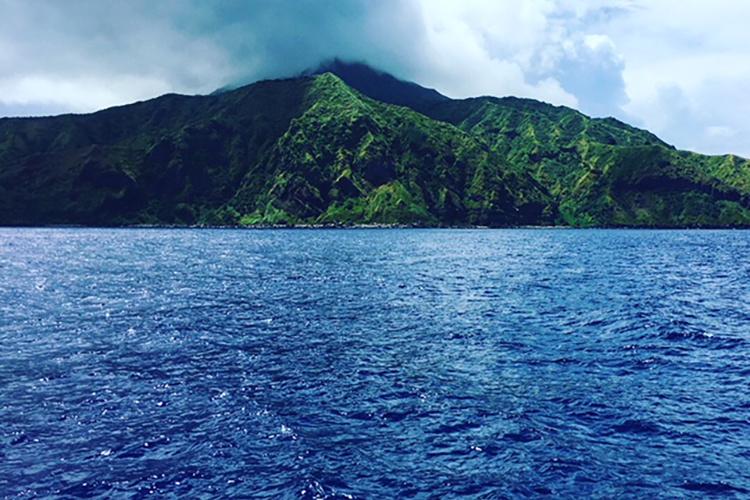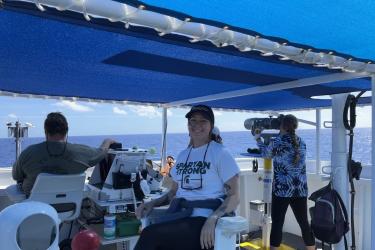When I began my internship with NOAA, I never anticipated an opportunity to actually ride out on one of their research vessels. It would feel like a dream to wake up and see a different island every morning, each with its own distinctive substrate, lined along its shores, that depict its geological history, and holds a magnitude of marine life. Earlier this June, I was lucky enough to join a group of scientists aboard the NOAA Ship Oscar Elton Sette, a multipurpose oceanographic research vessel, on an expedition around the Northern Mariana Islands.
The mission of this research expedition was to examine the life history of a variety of commercial deepwater and coral reef fish found along the Mariana Archipelago. This life history information is used to inform stock assessments on these commercial fishes and ultimately contribute to sustainable fishery management. We targeted commercially important deepwater species of fishes, such as snappers, including onaga, gindai, and ehu (the Hawaiian names of these fish), and groupers. We used hook-and-line attached to motorized reels to catch fish either from the large research ship or a smaller 19’ boat called the Steel Toe.

Snappers such as ehu (Etelis carbunculus), gindai (Pristipomoides zonatus), and yellowtail snapper (P. auricilla) are common deepwater commercial fishes around the Pacific Islands whose life history is crucial to understand in our mission to maintain sustainable fisheries (Photo: NOAA Fisheries/Max Lee).

Hook-and-line attached to motorized reels were stationed on the main vessel to capture deepwater fishes such as this beautiful and vibrantly colored lehi (Aphareus rutilans) (Photo: NOAA Fisheries/Max Lee).
Being out on the smaller boats felt like such an adventure! It gives you a close, first-hand experience with the ocean elements and the environment around the different islands. On the other small boats were groups of experienced spearfishers that targeted a variety of shallow-water reef fishes to bring back to the Sette at the end of the day. Reading and seeing pictures of fish in textbooks or movies doesn’t compare to the experience of catching and seeing these phenomenal species first-hand. I’ve never laid my eyes on something so vibrantly colored as the deepwater onagas that we would reel onto the boat.

The R/V Steel Toe was one of the small boats on the main vessel, NOAA Ship Oscar Elton Sette, which we used to catch deepwater fishes along the Mariana Archipelago (Photo: NOAA Fisheries/Max Lee).
After a day of fishing, the researchers and I processed the catch back onboard the Sette. “Processed” means that we measured and sampled each fish for future analysis—collecting gonads (reproductive organs), otoliths (ear bones), and fin clips for genetic analysis. We extracted gonads to identify the sex of each fish. The differences in the gonads usually make it relatively easy to distinguish between the sexes, but I’ve learned that it can be difficult to tell the difference if the gonads are small. That’s why we also saved the gonad samples for microscopic analysis in a lab to validate their sex.

All of the processing took place on board the Sette, where we took measurements, determined the sex of the fish, extracted otoliths, and collected genetic material (fin clips) for further processing (Photo: NOAA Fisheries/Max Lee).

Otoliths are calcium carbonate structures found within the head of a fish. They accumulate layers like the rings of a tree that allows us to count and estimate the fish’s age and growth rate (Photo: NOAA Fisheries/Max Lee).
Next, we extracted otoliths from the fishes. Otoliths are calcium carbonate crystalline structures in the head of the fish that function as the ear bones for the fish. Otoliths accumulate rings that can indicate the age of a fish, analogous to the rings in the trunk of a tree. I’ll spare you the gory details, but the otolith extraction process was probably the messiest part for me, but with practice, I was able to gain some skill and it became easier. The otolith samples weren’t analyzed on the ship like the gonads were, so we put them in separate containers for later analysis in a lab.
Besides the collecting, sampling, and processing that I did on this trip, I really enjoyed being part of a great community of scientists and ship’s crew. Living on a ship for two weeks, with just a handful of people, brought everyone close together (literally!). It’s a community dynamic that I can’t imagine experiencing anywhere else. I’ve gotten to know and grow comfortable with everyone I’ve met there, and that really enhanced the research experience. A big mahalo nui loa to everyone aboard the Sette and at the Science Center who helped foster such an incredible, life changing experience.
Meet the Blogger


